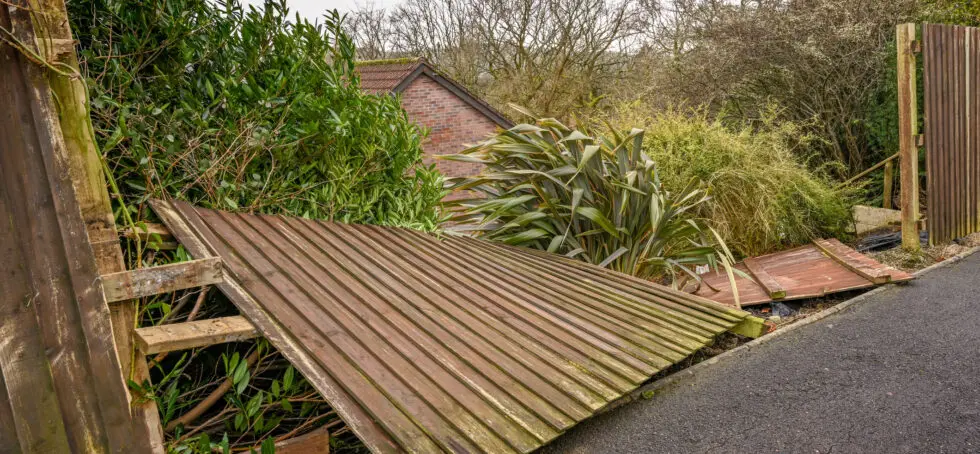Does home insurance cover storm damage?
Storm and wind damage are usually covered by home buildings and contents insurance. So if your home suffers storm and wind damage, your insurer should cover the cost of the repairs and usually provide you with a safe place to stay while your home is being repaired.
However, there are usually exclusions. For example, damage to fences and gates is usually excluded, as well as damage caused as a result of wear and tear or negligence. And insurers are known to dispute what constitutes a storm – read on for more on this.
What can I claim for after a storm?
Your home insurance will typically cover the following issues caused by wind, rain, snow, ice or hail:
- Roof damage
- Water damage
- Wind damage
- Sewer back-up
- Damage caused by frozen pipes.
Compare home insurance quotes from 50+ providers and find the best insurance cover for you today.
Proving storm damage for a claim
It can be difficult to prove storm damage because insurers use an official definition of a storm. According to the Association of British Insurers, a storm is a period of violent weather defined as:
- Wind speeds with gusts of at least 48 knots (55mph) equivalent to Storm Force 10 on the Beaufort Scale or;
- Torrential rainfall at a rate of at least 25mm an hour or;
- Snow to a depth of at least 1ft (30 cm) in 24 hours or;
- Hail of such intensity that it causes damage to hard surfaces or breaks glass.
This definition may be in your policy documents or your insurer may apply its own rules.
How do I make a storm damage insurance claim?
If your home has been damaged during a storm, contact your insurer ASAP. The majority of insurers have 24 hour helplines you can use in an emergency.
And as soon as it’s safe to do so, give your home a full inspection and list all the damage. Take photos and videos of the damage. And don’t start throwing things away even if they’re damaged. Keep everything you can in case you need to show your insurer evidence.
What if I need to carry out emergency repairs?
If you need repairs carrying out urgently, when you speak to your insurer you may find out it has emergency repair teams it can send out.
However, if they don’t, your policy may cover getting the work done. But make sure you tell your insurer that this work needs doing, and ensure you get receipts to submit as part of your claim.
Get an instant quote for home insurance, buildings or contents insurance. Compare quotes from 50+ biggest insurance brands. Find out more.
Compare Home Insurance Quotes
Compare Buildings & Contents Home Insurance cover from 50+ biggest insurance brands.
Get insurance quotes
How to prepare for storms
Maintaining your home reduces the chance of your home being damaged in a storm and should also reduce the chance of any claim for storm damage being rejected.
For example:
- Check your roof and get any loose or missing roof tiles replaced
- Make sure drains and guttering are clear
- Turn off the water to outside taps and insulate the pipes
- Fix any broken fence panels or walls
- Make sure any loose branches on trees in your garden are cut back.
Roof storm damage explained
Storms can cause all sorts of damage to roofs. Dislodged roof tiles are one of the most common forms of damage caused by strong winds. This is a particular risk if tiles are already loose and in older properties. While costs will vary, according to Checkatrade, “The average roof tile replacement cost is £170 for up to five broken tiles, presuming the replacement tiles can be easily sourced and there are no access issues.”
However, there are other factors to consider with roof tiles too. If a tile falls from your roof and damages a neighbour’s property, you may be liable – although they’ll need to show you’re at fault. So if your roof was already in a poor state before the storm they may be able to make a claim against you. While this should be covered by the legal liability part of your home insurance, it’s advisable to ensure your roof remains in a good state of repair.
Get an instant quote for home insurance, buildings or contents insurance. Compare quotes from 50+ biggest insurance brands. Find out more.
Does my home insurance cover me if a tree falls on my house?
Yes, most home insurers cover damage caused by falling trees or branches as standard. The exception is usually if the damage is caused during maintenance such as by a tree surgeon.
What if my neighbour’s tree damages my house?
If a neighbour’s tree falls on your house you’ll usually need to claim on your own insurance. This is because unlike car insurance, where your insurer can recover losses from a third party if you’re not at fault, home insurance only covers the owner’s property.
However, you might be able to make a claim against your neighbour if you can prove your neighbour was negligent. For example if the tree was known to be damaged.
If you’re making a claim on your home insurance because of a neighbour’s tree falling on your home, you’ll need to pay your policy’s excess. You can try to recover the excess from your neighbour through the small claims court but it’s usually best to sort out the issue between yourselves.
What if the tree was on public land?
If a tree that sits on public land falls on your home you should contact the council. While they may clear the tree away, you’ll need to claim on your own home insurance for any damage. However, similarly, if you feel the damage was caused as a result of the council’s negligence and want to seek financial redress you can make a claim.
Get an instant quote for home insurance, buildings or contents insurance. Compare quotes from 50+ biggest insurance brands. Find out more.
Fences and walls damaged: Who pays to fix them?
If a garden fence or wall has been damaged in the storms, before getting it repaired you should establish who is responsible for it. You can find out if a fence or wall is your responsibility by looking at your deeds. If it’s not clear, then you are reliant on ‘presumptions’ to establish who is responsible. For more on this read our guide Boundary Wall Rules: which fence is mine?
- If it’s your responsibility: It’s worth checking if any damage is covered by your buildings insurance. Although policies often exclude storm damage to fences, hedges and gates. So you may need to pay to fix it yourself.
- If your neighbour is responsible: Unless the existing fence is causing a safety hazard, there is actually very little you can do to force your neighbour to repair or replace it if they don’t want to.
Best home insurance for storm damage
Storm damage is becoming increasingly common; research by Aviva in 2024 found that 22% of UK homes had suffered storm damage in the last 5 years. So check your home insurance policy to see what storm cover it includes.
Also, with customers not being rewarded for brand loyalty, you should always shop around when your policy is up for renewal. Use our handy tool to compare home insurance quotes: you can get quotes from over 50 of the UK’s biggest insurers including M&S Bank, Tesco Bank and Endsleigh.
Compare home insurance quotes from 50+ providers and find the best insurance cover for you today.
Compare Home Insurance Quotes
Compare Buildings & Contents Home Insurance cover from 50+ biggest insurance brands.
Get insurance quotes
Is it worth claiming for storm damage on my insurance?
This will depend on a number of factors.
- Costs: Consider how much your excess is vs how much it would cost to pay to get the problem fixed yourself.
- Impact on renewal price: You may pay more for your next policy at renewal if you make a claim. However, if there is a widespread storm event impacting a large swathes of people and lots of people make claims for storm damage you may find your quote at renewal increases as a result, even if you haven’t claimed. So you might consider making a claim anyway.
And when it comes to your renewal, you should always shop around anyway. That is the best way to secure the best price. It also means you’ll get the right cover for your needs at the lowest price possible. For information on how to do this read our guide How to get the best home insurance deal
Frequently asked questions
Can I get compensation for a power cut?
Your electricity distribution company usually has 24 hours to restore your electricity supply if it fails as a result of a storm. If your power supply isn’t restored by this deadline, your energy firm should pay you £70. An additional £70 should be paid for each additional 12 hours without power. This is usually capped at £700.
You will normally need to make the claim with your energy supplier within three months of the problem being rectified. For more information on claiming and more read our guide what to do in a powercut.








